s4awx07 - Strategy & Business Economics Division
advertisement
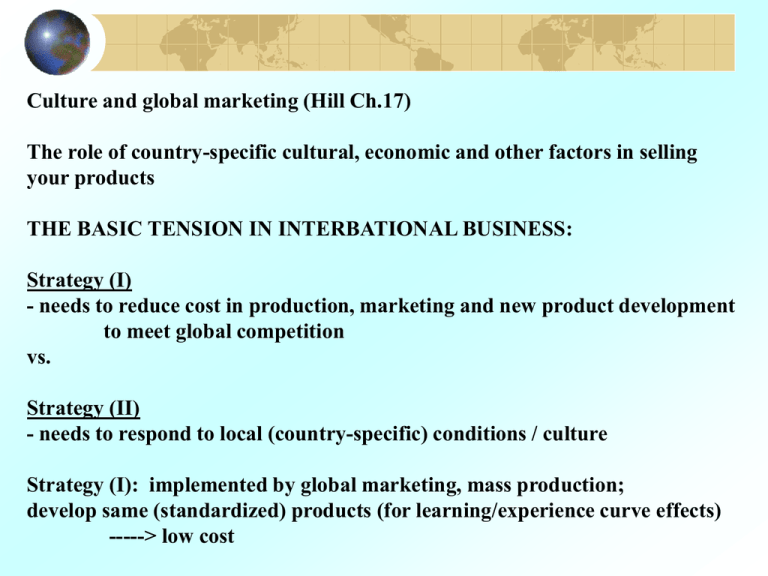
Culture and global marketing (Hill Ch.17) The role of country-specific cultural, economic and other factors in selling your products THE BASIC TENSION IN INTERBATIONAL BUSINESS: Strategy (I) - needs to reduce cost in production, marketing and new product development to meet global competition vs. Strategy (II) - needs to respond to local (country-specific) conditions / culture Strategy (I): implemented by global marketing, mass production; develop same (standardized) products (for learning/experience curve effects) -----> low cost Strategy (II): country-specific marketing; R&D activities for country-specific (customized) new product development and production ------> high cost Examples. Are taste and preferences the same in all countries? - instant coffee - McDonald’s hamburger - French perfumes (example to follow) - basic industrial products (steel,bulk chemicals,fertilizer,..) - Avon (example to follow) - Coca-Cola (mini-case, video, to follow) When will strategy (I) appropriate? Types of goods ? Services? When will strategy (II) appropriate? Competitive global firms: - choose an optimal mix of (I) and (II) above for each country market and each product to minimize cost and maximize profit (know-how) 5 factors to consider in choosing optimal mix of (I) and (II): 1. Product attributes Are the attributes of your global (standardized) products suitable to a particular foreign market? Matching based on culture level of economic development product (technical) standards required (e.g. measurement units, paper size, electricity / plugs,…) 2. Distribution strategy may get affected heavily by traditional arrangements in retail concentration channel length channel exclusivity but new arrangements can be successful and profitable (Toys R Us in Japan) 3.Communication strategy Communicating the attributes of your product to foreign customers affected by: cultural barriers (e.g. non-acceptable ads) source effects (e.g. consumers' image of seller and seller's status) noise levels (competitors' presence in ads) 4. Pricing strategy (A) Price discrimination If two countries have different price elasticities, then you don't have to charge the same price for the same product in the two countries. (Price discrimination possible) Price elasticity = (%change in demand) / (%change in price) High price elasticity --> elastic demand Example. Hill pp.598-603 considers a product market for which U.S. market not competitive (inelastic demand curve) Japanese market competitive (elastic demand curve) If you don't adopt price discrimination, then charge $43.58 per product in both countries. --> Your total revenue = $2,392.50 Under price discrimination, charge $40 per product in Japan and $65 in the U.S. --> Your total revenue = $2,575. Price discrimination pays! When will price discrimination fail? (B) Predatory pricing: dumping in foreign markets to gain market share; may face the antidumping charges and penalty (C) Experience curve pricing: pricing based on cumulative production on a global basis (legally justified low prices) 5. R&D, new product development (can be expensive) Selling your products in a foreign country may require modification of products and / or development of new products for that country, perhaps requiring Conduct R&D and development of new products for that country. Example. Costs of adapting products (Strategy II) Research &Development (“blueprint” costs) Market Cultivation Costs Line costs (new machinery) Switching costs (for existing machinery) Input price rises Consumer confusion costs Example. Reasons for Strategy II: Rise in willingness to pay (high profit margin) for adapted products; large mkt size; high expected mkt size growth, … CONCLUSION: Optimal mix of Strategies (I) and (II) require careful consideration of factors (1)-(5) above.


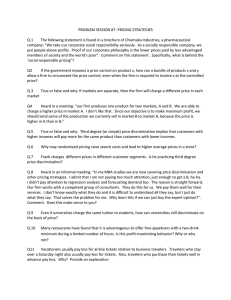
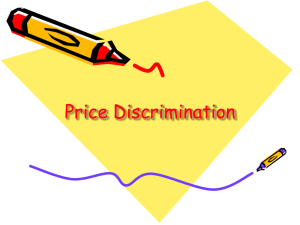
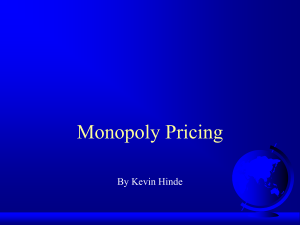



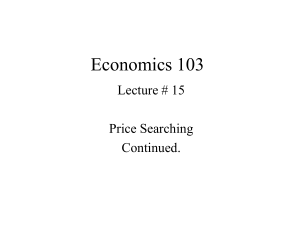
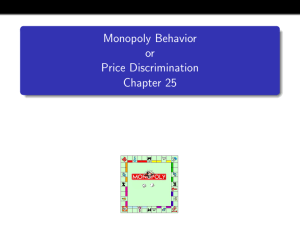

![Privacy, Economics, and Price Discrimination on the Internet [Extended Abstract] Andrew Odlyzko](http://s2.studylib.net/store/data/010298669_1-38906f936cc310b5f052772e8fe821a6-300x300.png)